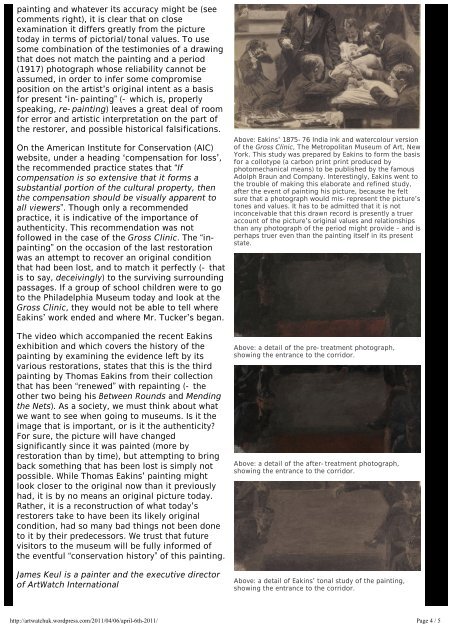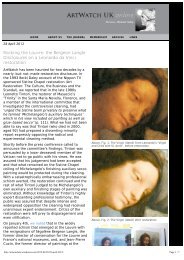Thomas Eakins' The Gross Clinic â A suitable Case for ... - Artwatch
Thomas Eakins' The Gross Clinic â A suitable Case for ... - Artwatch
Thomas Eakins' The Gross Clinic â A suitable Case for ... - Artwatch
- No tags were found...
You also want an ePaper? Increase the reach of your titles
YUMPU automatically turns print PDFs into web optimized ePapers that Google loves.
painting and whatever its accuracy might be (seecomments right), it is clear that on closeexamination it differs greatly from the picturetoday in terms of pictorial/tonal values. To usesome combination of the testimonies of a drawingthat does not match the painting and a period(1917) photograph whose reliability cannot beassumed, in order to infer some compromiseposition on the artist’s original intent as a basis<strong>for</strong> present “in-painting” (- which is, properlyspeaking, re-painting) leaves a great deal of room<strong>for</strong> error and artistic interpretation on the part ofthe restorer, and possible historical falsifications.On the American Institute <strong>for</strong> Conservation (AIC)website, under a heading ‘compensation <strong>for</strong> loss’,the recommended practice states that “Ifcompensation is so extensive that it <strong>for</strong>ms asubstantial portion of the cultural property, thenthe compensation should be visually apparent toall viewers”. Though only a recommendedpractice, it is indicative of the importance ofauthenticity. This recommendation was notfollowed in the case of the <strong>Gross</strong> <strong>Clinic</strong>. <strong>The</strong> “inpainting”on the occasion of the last restorationwas an attempt to recover an original conditionthat had been lost, and to match it perfectly (- thatis to say, deceivingly) to the surviving surroundingpassages. If a group of school children were to goto the Philadelphia Museum today and look at the<strong>Gross</strong> <strong>Clinic</strong>, they would not be able to tell whereEakins’ work ended and where Mr. Tucker’s began.<strong>The</strong> video which accompanied the recent Eakinsexhibition and which covers the history of thepainting by examining the evidence left by itsvarious restorations, states that this is the thirdpainting by <strong>Thomas</strong> Eakins from their collectionthat has been “renewed” with repainting (- theother two being his Between Rounds and Mendingthe Nets). As a society, we must think about whatwe want to see when going to museums. Is it theimage that is important, or is it the authenticity?For sure, the picture will have changedsignificantly since it was painted (more byrestoration than by time), but attempting to bringback something that has been lost is simply notpossible. While <strong>Thomas</strong> Eakins’ painting mightlook closer to the original now than it previouslyhad, it is by no means an original picture today.Rather, it is a reconstruction of what today’srestorers take to have been its likely originalcondition, had so many bad things not been doneto it by their predecessors. We trust that futurevisitors to the museum will be fully in<strong>for</strong>med ofthe eventful “conservation history” of this painting.James Keul is a painter and the executive directorof ArtWatch InternationalAbove: Eakins’ 1875-76 India ink and watercolour versionof the <strong>Gross</strong> <strong>Clinic</strong>, <strong>The</strong> Metropolitan Museum of Art, NewYork. This study was prepared by Eakins to <strong>for</strong>m the basis<strong>for</strong> a collotype (a carbon print print produced byphotomechanical means) to be published by the famousAdolph Braun and Company. Interestingly, Eakins went tothe trouble of making this elaborate and refined study,after the event of painting his picture, because he feltsure that a photograph would mis-represent the picture’stones and values. It has to be admitted that it is notinconceivable that this drawn record is presently a trueraccount of the picture’s original values and relationshipsthan any photograph of the period might provide – and isperhaps truer even than the painting itself in its presentstate.Above: a detail of the pre-treatment photograph,showing the entrance to the corridor.Above: a detail of the after-treatment photograph,showing the entrance to the corridor.Above: a detail of Eakins’ tonal study of the painting,showing the entrance to the corridor.http://artwatchuk.wordpress.com/2011/04/06/april-6th-2011/ Page 4 / 5




